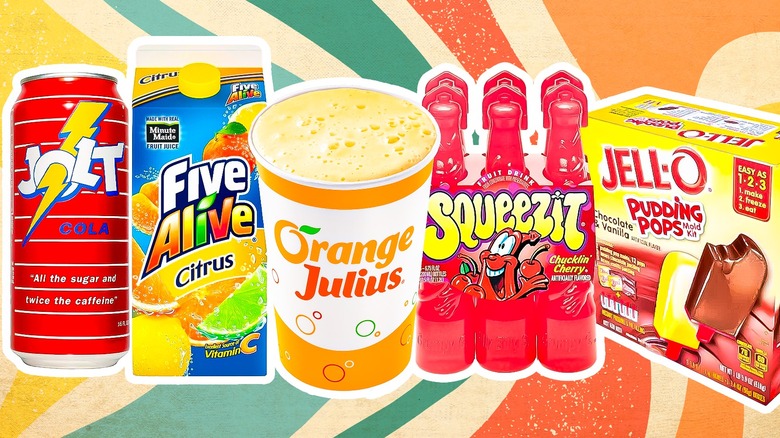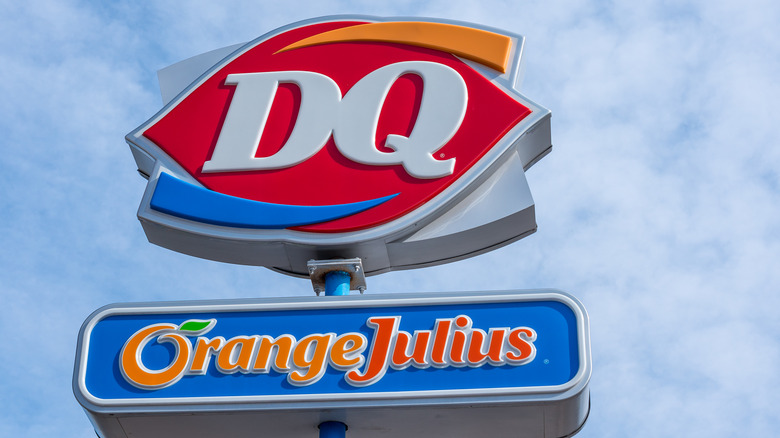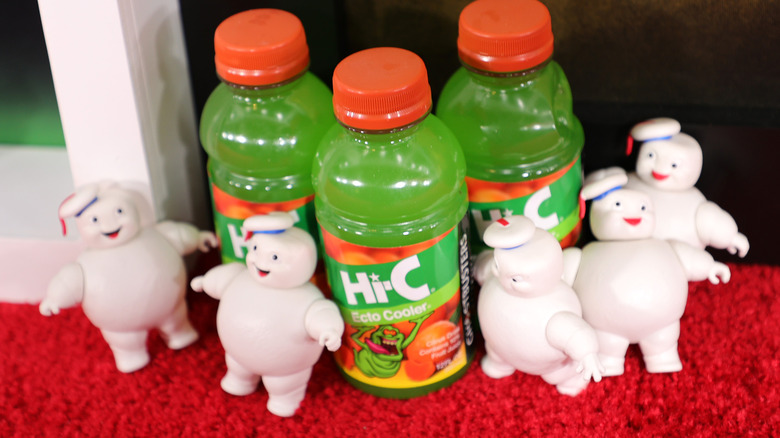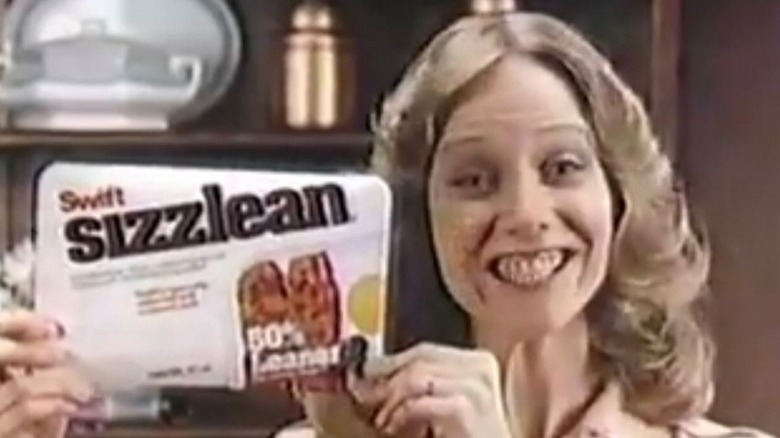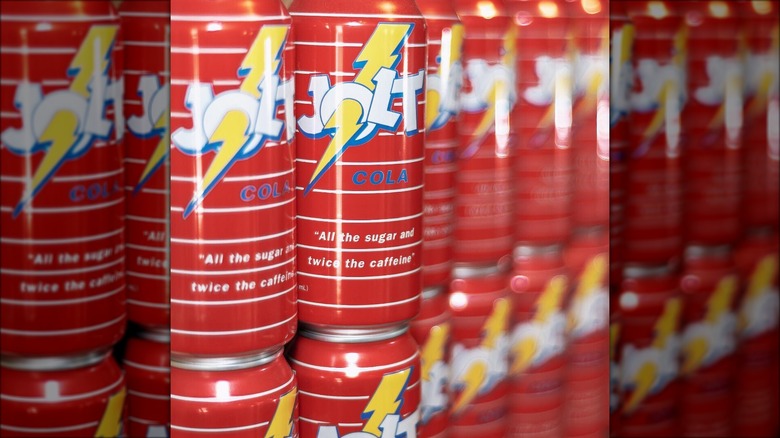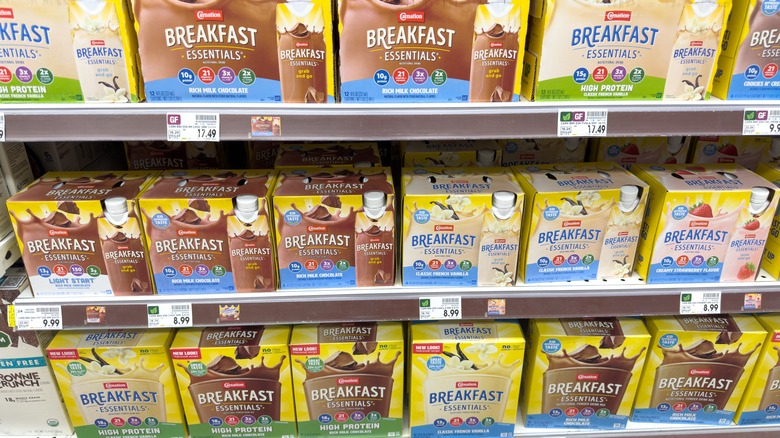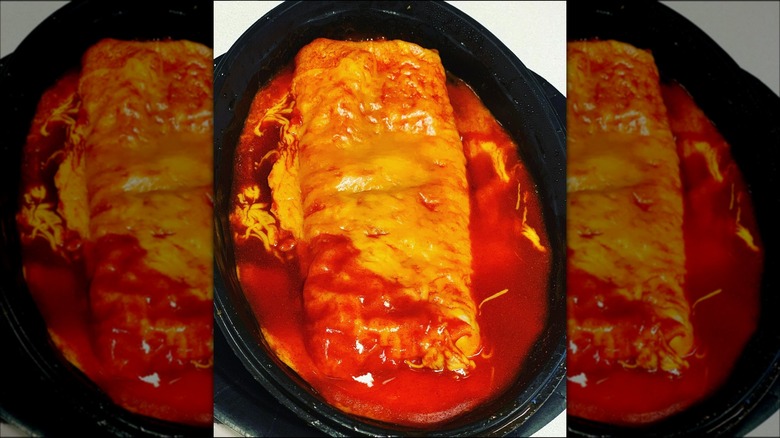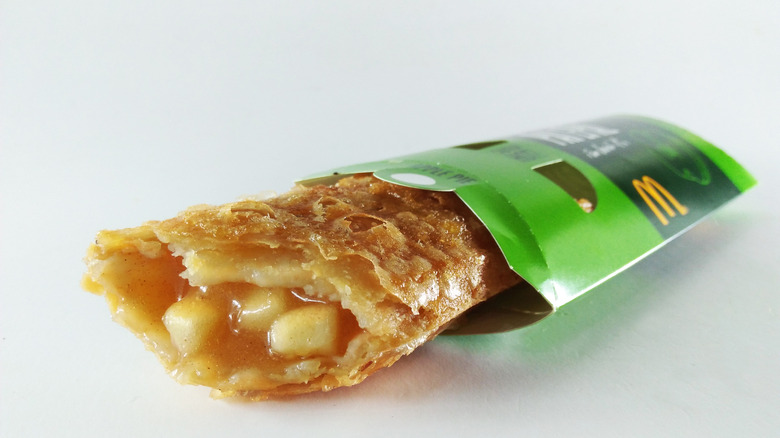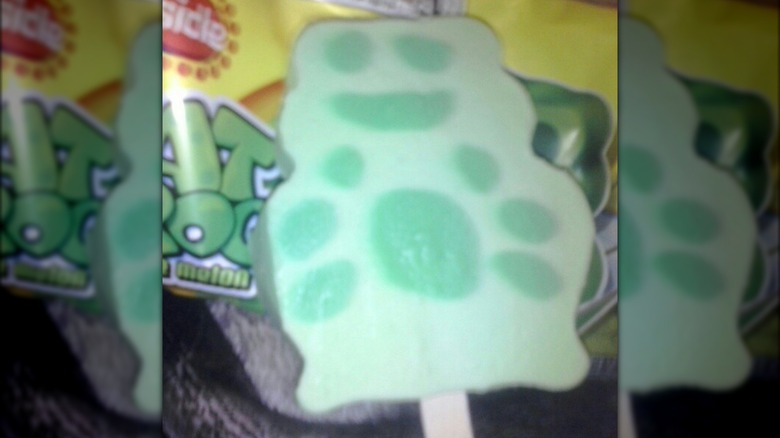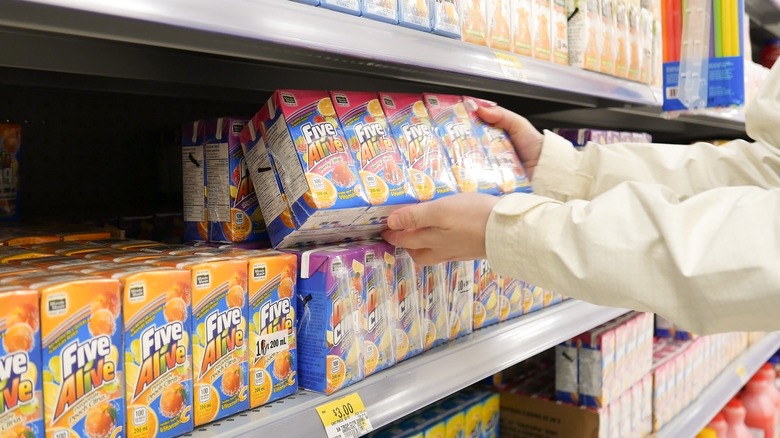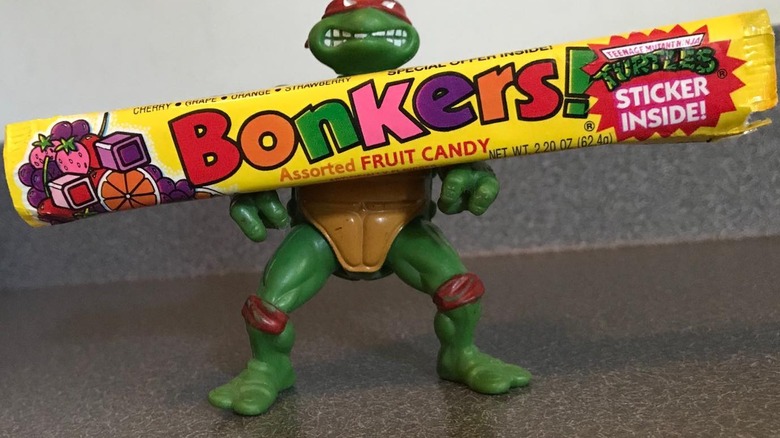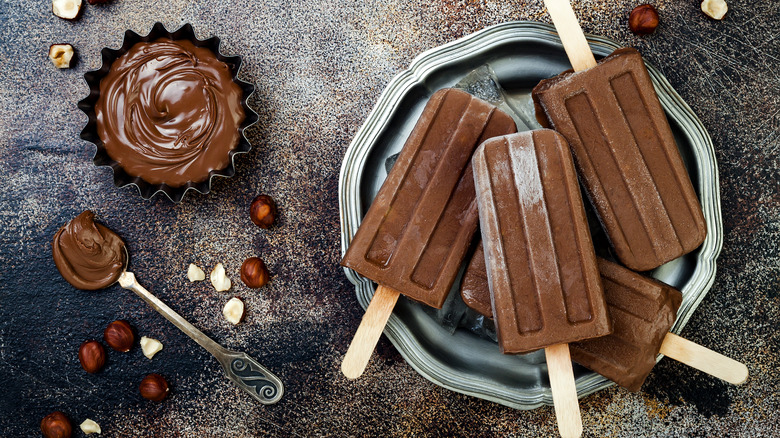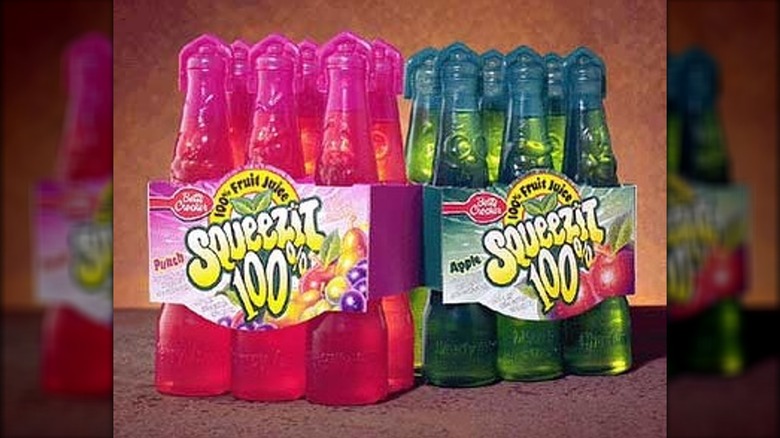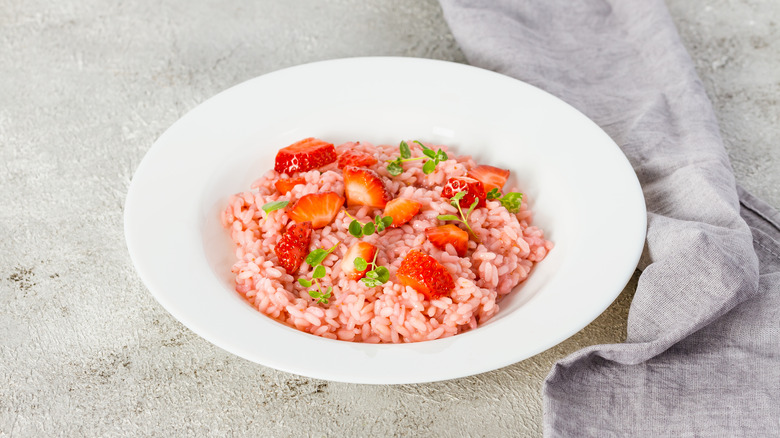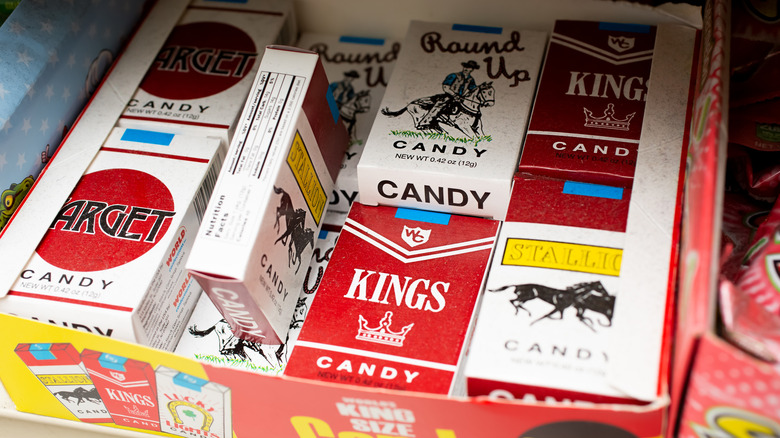14 Foods From The '80s You Probably Forgot About
The 1980s were an odd time to be alive in America. Popular hard-headed, soft-bodied baby dolls with unusual names and adoption papers, known as Cabbage patch dolls, were causing fights in malls. An actor, rather than a politician, became president (though this, seems less odd now). Smoking was still allowed in restaurants and on airplanes, and people were reliant on paper maps rather than mobile phones to know where they were going.
Despite the questionable events and trends of the time, nostalgia remains the sweetest seasoning, making everything it touches, no matter how sour, that much more palatable. When it comes to some of the big food trends and products of the era, there were some real head-turners in the '80s. So unusual, yet so fondly remembered, they could only have been from that time when big shoulder pads and even bigger hair seemed to have had some collective side effect on public opinion and taste. Scroll on to relive, or simply gasp in horror, at some of the decade's most unusual food products that will forever remain a part of '80s nostalgia.
Orange Julius
It's 1985. The local mall, specifically the food court is the preferred teen hangout of choice. Sbarro, Panda Express, and Auntie Anne's were the food staples of the era – with the now rare-to-find Orange Julius the preferred mall beverage.
Despite its peak era of the 1980s, Orange Julius had been around for decades. The business's humble beginning stemmed from an orange juice stand in Los Angeles and the desire to make the drink creamier and less acidic on the stomach. It was founded in 1926 by owner Julius Freed and real estate agent Bill Hamlin, who created the creamy elixir due to a sensitive stomach.
From there, the creamy, orange beverage made its way around state fairs before eventually moving into shopping malls across the country. Orange Julius was even known as the official drink of the World's Fair in 1964. In the late '80s, Orange Julius was bought by Dairy Queen, who began using more artificial ingredients rather than freshly squeezed juice. In 2023, DQ is now phasing out the drink altogether, which means its sweet vanilla-meets-orange-juice taste will forever remain linked to the food courts of the past rather than the present.
Hi-C Ecto Cooler
Anyone who sat at the cool kids' table in the 1980s will tell you that if it wasn't Squeezits, the beverage de jour was the neon green glow of Hi-C Ecto Cooler. It was recognizable by its rectangular juice box packaging with Ghostbuster's notorious Slimer on the front and the distinctive orange and tangerine juice-like flavor, made primarily from sugars. The disturbingly green beverage only contained 10% fruit juice, as it proudly boasted on each label.
Slimer slipped his way off of the product in the late '90s with the brand relabelling the same flavor as 'Shoutin' Orange Tangerine' in Slimer's absence. Recently, Ecto Cooler had a relaunch, with a limited edition drink giveaway put out in conjunction with the movie "Ghostbuster: Afterlife" with a Slimer-like character on the cover of the 12-ounce plastic bottles (no juice boxes this time). Sadly, this was simply a cameo appearance from the character and the drink, with both fading away from supermarket shelves shortly after that. The flavor and color, however, will forever remain in the aging memories of every school-aged child during the era.
Sizzlean
Though most of us will have never heard of Sizzlean, it was a household name during the '70s and '80s, which turned up on many household breakfast tables. Sizzlean was marketed as a healthier alternative to bacon, meaning (during that era) it had less fat than the pork-belly alternative, with a reported jerky-like texture.
Sizzlean had the transformative power of turkey meat to thank for its lower fat attributes, which was mixed in alongside pork and beef to create the final product of bacon-like strips, fried and used in the same way but with less reduction in size when cooked. Later, an 'all beef' version also went to market, which surprisingly still had turkey but no pork. The brand made sure to let customers know it was made with real meat, without soy or other alternative that might fare better in today's market.
The product, produced by Swift & Co., sold widely throughout the 80s and 90s, but once the low-fat era began to die out, so too did Sizzlean. The product was officially discontinued in 2005.
Jolt Cola
Launched into the world in 1985, Jolt Cola was known for its heart-racing amount of caffeine, complete with a healthy dose of sugar guaranteed to get your brain and body buzzing with an artificial amount of energy. Pre-dating the variety of energy drinks soon to sweeten the market, Jolt was essentially the Red Bull, Monster, or Prime of the '80s. It was said to be made as a pushback to all of the 'diet' marked artificially sweetened drinks taking over the carbonated beverage market.
In 2009, Jolt filed for bankruptcy, unable to fulfill the predicted sale of 90 million cans of a custom-ordered design. Given a brief reboot in 2017, Jolt made an exclusive appearance at Dollar General before eventually fading out of sight for good, save for the occasional cameo on eBay, which quite frankly should raise some eyebrows as to whether or not these products are still fit for consumption (if they ever really were in the first place).
Carnation breakfast bar
Those who had difficulty getting out of bed in time for breakfast before having to run out the door might fondly remember Carnation's breakfast bars. The chocolate-covered granola bars were packed with protein and fortified with other nutrients. The bars were officially brought to market in the mid-'70s, becoming more popular in the 1980s and into the early '90 before being discontinued. Though eating on the go has become all too commonplace, in the '80s, it was a relatively new trend. Carnation was also known for its nutrient-dense shakes, often touted as a meal replacement for dieters of that time.
There was an attempt to relaunch the breakfast bars twice; the first was in the mid-'90s, but with so much more competition now on the market, the product never saw enough results to keep it a viable market option. Carnation tried a relaunch again in 2014, but according to reviews, the flavors just didn't hit like nostalgia did.
Taco Bell Enchirito
Indecisive Taco Bell customers of the 1980s felt seen by the brand's Frankenstein product, which meant you didn't have to choose between an enchilada and a burrito. Fan favorite enchirito was a much-loved item by many, so much so that people are still talking about it forty years later.
Comprised of a soft flour tortilla with beef, beans, and onions, then rolled and slathered with red sauce and melted cheese, the enchirito was a Taco Bell staple until the company eventually removed it from the menu in 2013. However, so popular, with high demands for its return, the Enchirito made a brief but brilliant comeback that made national news headlines.
Sadly, all good things must come to an end. Though Taco Bell no longer has the hybrid dish on its official menu, that doesn't mean you can't make a pretty decent alternative, either by ordering a Burrito Supreme with extra side sauces or considering alternative restaurants like Baja Fresh, Chuy's or simply making your own version of the dish with beef enchiladas at home.
McDonald's deep-fried apple pies
Today's children will never know just how scalding hot the inside of a McDonald's deep-fried apple pie really was. Though it was as dangerous as the sun's surface, in terms of damage done to tongues without enough patience to let it cool down first, it was worth the risk. Today's baked version, though safer and reportedly healthier, just doesn't cut the mustard by comparison.
The pie first landed on McDonald's counters in the 1940s as an individual slice rather than something that could easily be transported. It only saw its way into the deep fat frier in the late 1960s, once it had been sealed into more of a turnover-like shape to protect the filling from leaking out. The deep-fried pastry was then served in a cardboard sleeve to protect hands, though tongues and the roof of mouthes were more at risk of burns than ever before.
Once the U.S. careened itself into the low-fat, Snackwell's filled era of the early '90s, the deep-fried apple pie was on the chopping block, replaced with its lower-fat baked alternative, which remains in place today. Deep-fried alternatives are being offered at Popeye's, Hardee's, and other fast food chains — just not from the original golden arches.
Good Humor Fat Frogs
Ahh, the good old days when, in the warmer months, just as dinner was finishing, the familiar tune of the ice cream van would come whistling through the neighborhood. Kids would run barefoot out the door, parents trailing close behind with their wallets. The top choices of that area were between an ice cream sandwich, creamsicle, a chocolate or strawberry good humor bar, or the classic Fat Frog. Today, sadly, the Fat Frog is no longer on the menu.
Fat Frogs were a fruity, ice cream-like flavor with a secondary reward via the frog's two red, bubble gumball eyeballs. The trick was attempting to save the gumballs until last without the rest of the fruity fat frog melting and dripping all over. Working out how best to eat the frozen treat was a learning curve.
Not to be confused with the 'Fat Frog' treats of Ireland, a teen-marketed wine cooler-like drink and, separately, another type of discontinued frozen treat that has left people in a panic, with desperate calls to bring them back to the market.
Five Alive
The 1980s saw many odd beverages come onto the market, from Jolt to Crystal Pepsi Hi-C to Five Alive. Originally brought to market in the late '70s under the Minute Made brand, Five Alive was the juice that combined five citrus fruits: orange, lemon, lime, tangerine, and grapefruit, into one carton or concentrated frozen container for customers to make at home. Produced by Coca-Cola, Five Alive later came in alternative flavors like peach citrus, tropical citrus, and berry citrus in certain North American regions.
Though hard to find now in the U.S., one such fan managed to track one down at his local Kroger in Kentucky. Largely, however, it seems that the juice has been discontinued across the U.S., with limited availability in Canada. No one can seem to place their finger on exactly when or why it died out. However, some believe that competing Fruitopia (also now discontinued), released in the mid-'90s under the Minute Made brand, might have been a strategic or unintended factor in the juice's undoing.
Bonkers!
Bonkers! was a soft, chewy, rectangular, sweet candy with a fruity center, put out by Nabisco in the '80s. More than their flavor, they might have been remembered for their commercials, containing perilous giant falling fruit that would 'bonk you out.' Their soft texture and chunky size, similar to the gum Hubba Bubba, made them extra satisfying to chomp down on, only to be rewarded with a separate burst of fruit. Bonkers! came in various flavors, including watermelon, grape, orange, cherry, and not-so-fruity chocolate. The candy was sold in individually flavored packets, each candy wrapped separately.
Once the commercials stopped, candy sales began to drop, making it a product that needed constant marketing to succeed. By the late '90s, Bonkers! had bonked their way off shelves altogether, leaving disappointed customers in their wake. Acquired by Leaf Brands in 2012, Leaf Brands attempted to bring this nostalgic candy back for a short but sweet reunion tour, during the summer of 2018. After one last burst of fruity flavor, the brand has since disappeared, remaining only in memories and commercials now available on YouTube.
Jello Pudding Pops
Any child of the '80s will only need to hear the words 'pudding pop' to begin the Pavlovian response of salivating and lip licking involuntarily. Pudding pops were two magical words for children of this decade. Cold, creamy, and chocolaty with a slightly frosty outer layer, they were a treat for every good boy and girl.
Jell-O first expanded their offerings from all things jiggly to include frozen treats in the 1960s, taking their famous puddings and transforming them into frozen popsicles by the '70s. During the first year of sales, Pudding Pops grossed over $100 million, tripling the sales just a few years later. Yet, according to Jell-O, the product was too expensive to keep on the market. An official statement was made by Jell-O in 2018, detailing that the demand was just too low to keep the product on the market.
That said, nothing is stopping you from freezing your next batch of homemade chocolate pudding to relive the glory days of the pudding pop.
Squeezits
Squeezits were unequivocally the coveted drink of 1980s American lunchboxes. Brightly colored plastic bottles, complete with a twist-off cap, were filled with sugar-filled drinks that were likely more closely related to boiled-down Skittles than they ever were to fruit juice. Thanks to a crack team of marketers who knew exactly what kids would want, their appeal was palpable.
Squeezits entered the world in the mile-high city of Denver in 1985 before eventually making their presence known nationwide by 1988. They were just as much about the bottle as they were about its contents. From bottles that changed colors to black 'mystery flavored' varieties to its ability to be repurposed as a tiny but effective squirt gun after their contents had been consumed, Squeezit bottles were an entity and a symbol of cool, far more than most other snacks and products at that time.
By 2001, however, Squeezit's time in the spotlight had come to a close, having used up all possible marketing techniques from Life Saver flavors to characters for each flavor like Grumpy Grape and Chucklin' Cherry, to actually making the drinks from juice. Despite a brief comeback in 2006, plastic-laden, artificially flavored drinks are a thing of the past, not the future.
Strawberry Risotto
The '80s were the decade that favored the Italian American restaurant, from blackened fish to pasta primavera and pesto everything. Many of the trends of the 1980s were centered around the American interpretation of Italian cuisine. So, too, is the strawberry risotto, though this dish could also be made at home as a creative way to repurpose overly ripe berries into something seemingly sophisticated.
Strawberry risottos were all over Italian restaurants up and down the country, relying on the addictive qualities of the sweet meets savory combination. This pink-hued dish, made with chicken stock, dry wine, ripe strawberries, and plenty of Parmesan, was definitely on the main menu, not the desserts.
The dish was an American interpretation of risotto, which, according to some, made for a tough sell, despite its appealing taste and pretty presentation. The difficult sales will likely keep the dish off menus unless it is for a specific retro theme. However, it's easy enough to recreate at home and will probably appeal to even some of the fussiest of children, thanks to the power of its jubilant pink hue.
Candy Cigarettes
If you were a child of the '80s, and you don't have memories of puffing away on candy or bubblegum cigarettes — were you really a child of the '80s? Though it seems unbelievably strange to think these candies, simulating such harmful products, were aimed at children, perhaps it is no worse than all of the fruity-scented vapes and colorful vape accessories of today's market. The links between pretending to smoke as a child and the potential for developing this harmful habit as an adult were strong enough to eventually affect the market by changing how the candy was packaged.
Certain states went as far as to ban the product altogether, though the laws could never fully make it on a national level, unlike other countries like Turkey, Ireland, and Norway. While the specifically named 'cigarette' part of the candy cigarette has been removed, as have the cigarette brand-mimicking labels, the cigarette-mimicking sticks are still around, just in a variety of slightly less conspicuous forms.
